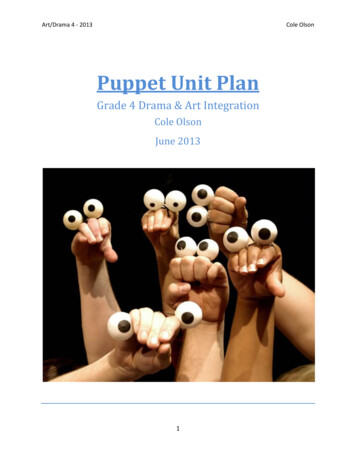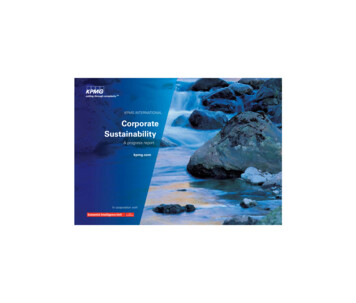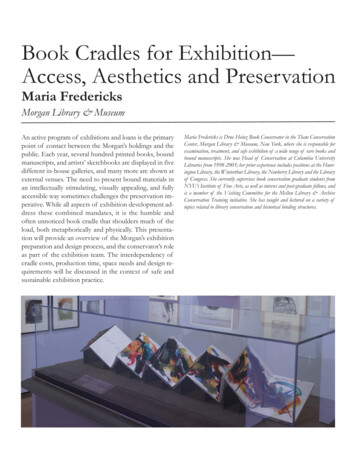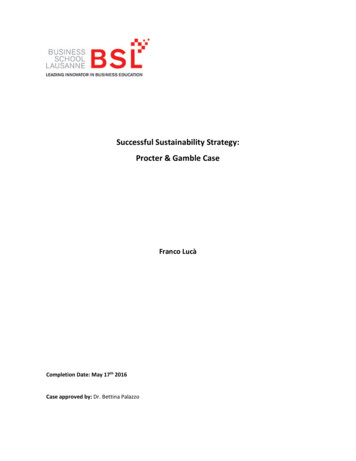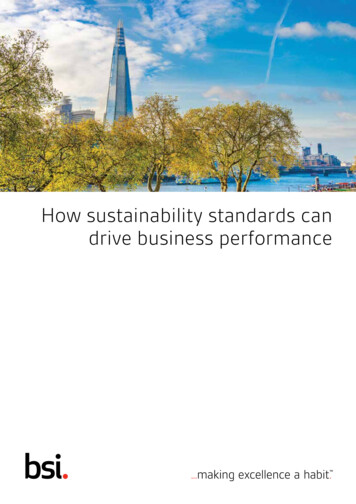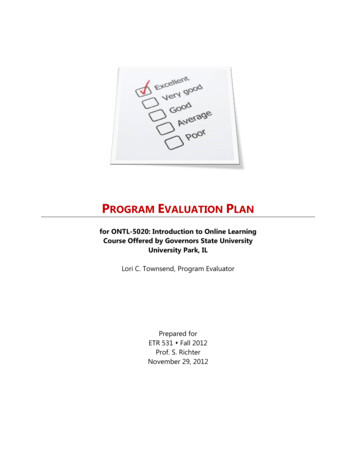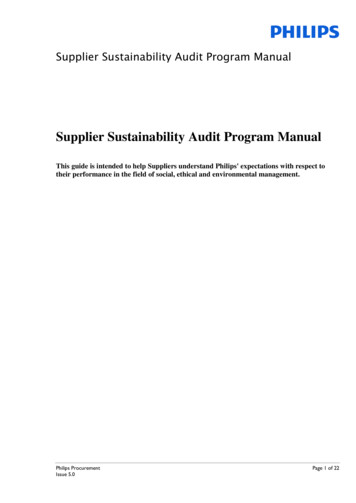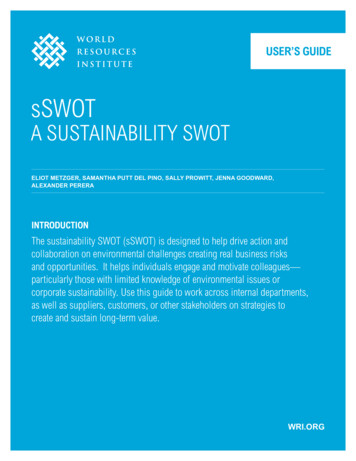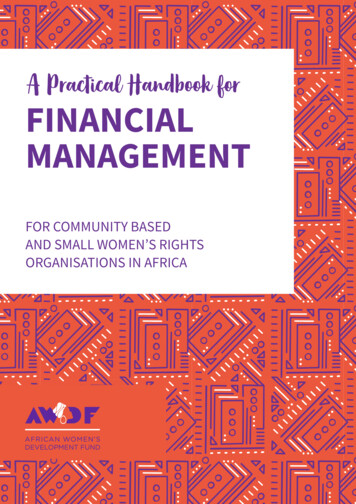
Transcription
Sustainability: ExhibitionSummative Evaluation ReportCommunity Environmental Services in Partnership with OMSISub-titlePrepared byRenée Bogin Curtis, EvaluatorCommunity Environmental Services, Portland State UniversityDecember 31, 2014Funded by the National Science Foundation, Grant No. DRL-0917595With the generous support of:
Table of ContentsExecutive Summary . 2Introduction to the Sustainability Project . 4Overview of Clever Together/Juntos somos ingeniosos . 5The Development of Clever Together/Juntos somos ingeniosos . 5Measures of Success . 6Evaluation Methods . 7Findings . 9Exhibit Impact Discussion . 20Considerations and Lessons Learned for the Field . 22Appendix I. Recruitment Flyer in English & Spanish . 23Appendix II. Exhibit Components . 25Appendix III. Participant Survey . 27Appendix IV. Exhibit Logic Model and Measures of Success . 29This material is based upon work supported by the National Science Foundation under Grant No. DRL0917595. Any opinions, findings, and conclusions or recommendations expressed in this material arethose of the author(s) and do not necessarily reflect the views of the National Science Foundation. December 2014 Portland State UniversitySustainability: Exhibition Summative Evaluation Report1
Executive SummaryOverview of the Sustainability ProjectAs part of the National Science Foundation funded Sustainability: Promoting Sustainable DecisionMaking in Informal Education project, the Oregon Museum of Science and Industry (OMSI) and itspartners developed a bilingual (Spanish/English) exhibition, event series, outreach campaign including apublic website, and a professional development website and workshop . The goal of these deliverableswas to promote sustainable decision making by building skills that allow participants to weigh thetradeoffs of their choices and thereby choose more sustainable practices. The project duration wasSeptember 2009–April 2015. Portland State University (PSU), in collaboration with OMSI, supportedmany phases of evaluation during the project and led all summative evaluation activities.Overview of Clever Together/Juntos somos ingeniososClever Together/Juntos somos ingeniosos is: A 1,500 square foot permanent, bilingual (English/Spanish) exhibition at OMSI that promotessustainable decision making by enabling visitors to build skills, weigh tradeoffs of their choices,and to feel comfortable choosing more sustainable practices. A hands-on approach to sustainability that focuses on environmental, economic, and socialconsiderations: the three pillars of sustainability as defined by the United Nations. An experience designed specifically to focus on everyday choices regarding food,transportation, consumption, and energy in the Portland metro region.The exhibition includes eight individual components designed to deliver the impacts outlined below aswell as to communicate the project’s big idea: We can cultivate a more sustainable community bybuilding skills and making decisions that maximize positive impacts.The summative study evaluated the exhibition’s achievement of the following impacts:1. Participants will understand skills associated with sustainable decision making in their everyday lives.2. Participants will be encouraged to engage in more sustainable practices in the followingcategories: Transportation, Energy Conservation, Consumption & Waste, and Food.Key ResultsThe findings are based on surveys conducted within the Clever Together/Juntos somos ingeniososexhibition. Family groups of one adult parent/caregiver and one child aged 10–17 were recruited forparticipation. Family groups included 30 English-speaking families (Group 1) and 21 Spanish-speakingfamilies (Group 2). Responses are reported as family group responses, not individual participantfeedback. Findings are organized by participant group, but not for comparative purposes. Comparisonbetween the two groups was not a goal of the evaluation and is not encouraged. The targetedoutcomes – or measures of success – were influential in the design of the questions, but the results didnot always provide direct indications of whether or not outcomes were achieved. Rather, the success ofsome outcomes was inferred indirectly based on the results, and sometimes from more than onequestion. Rich data, when available, were used to gain significant insights into participant attitudes andunderstandings beyond the intended outcomes, but on occasion data were not substantive enough toyield deeper insights. Yet the findings demonstrate that, overall, the project successfully achieved theintended outcomes and impacts.Sustainability: Exhibition Summative Evaluation Report2
Impact Summary TableImpact 1 Outcome Indicators1. Over 70% of participants willcapture the big idea: We cancultivate a more sustainablecommunity by building skills andmaking decisions that maximizepositive impacts.2. 50% of participants willunderstand skills that supportsustainabledecision-making abilities.3. Over 60% of participants willidentify available options to makemore sustainable decisions.Impact 2 Outcome Indicator4. At least 65% of participants willreport that they will intend tomake more sustainable decisionsin any of the following areas:a. Transportationb. Energy Conservation.c. Consumption & Wasted. FoodEvidence of Outcome (Measure of Success)100% of Group 1 and Group 2 families captured the big idea, asindicated by responses that identified the impacts of at leastone of the three pillars of sustainability. The environmentalpillar was mentioned most frequently, by 69% of Group 1 and62% of Group 2 families. All families in both groupsdemonstrated at least a basic understanding of the big ideawhen asked what factors to consider when making choices. 90%of Group 1 and 96% of Group 2 reported their choices can have amedium or large impact on their community.87% of Group 1 and 100% of Group 2 families identified ways tocontribute to a sustainable community. Responses reflected anunderstanding of skills that support sustainable decisionmaking abilities. The most common content areas mentionedwere Energy Conservation and Waste & Consumption.87% of Group 1 and 100% of Group 2 families were able toidentify available options.Evidence of Outcome (Measure of Success)All families in both groups reported they are very likely or likelyto make sustainable decisions after visiting the exhibit. 87% ofGroup 1 and 76% of Group 2 families reported they are verylikely to make sustainable decisions. Additionally, at least 90%of Group 1 and 87% of Group 2 families were able to identifysustainable choices in each of the content areas.Conclusions & Recommendations for the FieldSurvey results indicated all outcomes were achieved. Families captured the big idea. Theydemonstrated awareness of factors that support sustainable decision-making skills and identified ideas,and examples that support those skills. Families also reported that they intend to make sustainabledecisions in the future.The following recommendations for future projects emerged from the evaluation findings: Continue to build on decision-making skills using the three-pillar framework. Partner with Hispanic-serving organizations to recruit attendees and study participants. Sustainability is a challenging concept. Promote more understanding of decision-makingskills. Encourage learners with higher levels of sustainability understanding to motivate others.Sustainability: Exhibition Summative Evaluation Report3
Introduction to the Sustainability ProjectAs part of the National Science Foundation funded Sustainability: Promoting Sustainable DecisionMaking in Informal Education project, the Oregon Museum of Science and Industry (OMSI) and itspartners developed a bilingual (Spanish/English) exhibition, event series, outreach campaign, andwebsite for the public. The goal of these deliverables was to promote sustainable decision making bybuilding skills that allow participants to weigh the tradeoffs of their choices and choose moresustainable practices. The project duration was September 2009–April 2015.The project team used a positive, story-based approach to engage the target public audience ofEnglish- and Spanish-speaking families in the Portland metropolitan area. The deliverables focused onpeople and places in the area and highlighted simple choices available to everyone.The project also features professional audience deliverables that build upon the groundbreaking workalready done at OMSI in the area of sustainable exhibit development, design, and fabrication.Project Goals1. Promote sustainable decision making.2. Promote sustainable practices for developing, designing, and fabricating exhibits.Target AudiencesPublic Audience Families, with a focus on families with middle and high school aged youth Residents of the Portland metro area (Clackamas, Washington, and Multnomah counties) Underserved audience: parents who prefer to speak Spanish and their familiesProfessional Audience Exhibit developers, designers, and fabricators in non-profit and for-profit sectors Secondary audiences include museum administrators and others working in Informal ScienceEducation (ISE) organizationsProject Deliverables A 1,500 square foot bilingual (Spanish/English) exhibition, Clever Together/Juntos somosingeniosos, designed to engage the public in developing an understanding of the skills needed forsustainable decision making in their everyday lives Bilingual (Spanish/English) outreach campaign that uses access points outside of the museum toencourage people to engage with sustainability-related stories and activities via cellphone orcomputer (Local Voices, Clever Choices/Nuestras voces, nuestras decisiones campaign) Eight bilingual (Spanish/English) museum events about sustainable living ExhibitSEED workshops for museum professionals on sustainable exhibit development A set of documented practices and guidelines, tools, and resources for sustainable exhibitdevelopment, design, and fabrication that may become an industry standard (ExhibitSEED.org)Project Partners Coalition for a Livable Future Metro Regional Government Portland Bureau of Planning and SustainabilitySustainability: Exhibition Summative Evaluation Report Portland Community College Verde4
Overview of Clever Together, Juntos somos ingeniososClever Together, Juntos somos ingeniosos is: A 1,500 square foot permanent, bilingual (English/Spanish) exhibition at OMSI that promotessustainable decision making by enabling visitors to build skills, weigh tradeoffs of their choices,and to feel comfortable choosing more sustainable practices. A hands-on approach to sustainability that focuses on environmental, economic, and socialconsiderations to decisions. An experience designed specifically to focus on everyday choices regarding food,transportation, consumption, and energy in the Portland metro region.The exhibition includes eight individual components designed to deliver the impacts and indicatorsoutlined below and in the exhibition logic model (See Appendix IV) as well as to communicate theproject’s big idea: We can cultivate a more sustainable community by building skills and makingdecisions that maximize positive impacts.The Development of Clever Together, Juntos somos ingeniososA team of OMSI exhibit research and development, evaluation, design, and production staff developedthe Clever Together/Juntos somos ingeniosos exhibition based on the following evaluation, research, andexpert advice: Front-end literature research on similar projects, target audiences, and what influencessustainable decision making Front-end evaluation about existing understandings of sustainability and sustainable decisionmaking conducted by external evaluators from Portland State University’s (PSU’s) CommunityEnvironmental Services (CES) and OMSI’s Visitor Studies and Evaluation team Advisor input solicited at two advisor meetings Partner input solicited at the two advisor meetings and partner meetings held every 2–4 weeksthroughout the project Formative evaluation conducted by OMSI’s Visitor Studies and Evaluation team and externalevaluators from CES regarding visitors’ reactions to prototype exhibits Remedial evaluation conducted by OMSI’s Visitor Studies and Evaluation team and externalevaluators from CES to evaluate the use of the completed exhibition during its first threemonths on display at OMSIDeveloping the DeliverablesFront-end evaluation was critical for the development of the overarching structure and messages in theClever Together/ Juntos somos ingeniosos exhibition. During the front-end evaluation, surveys conductedwith English- and Spanish-speaking public audiences indicated that the terms “sustainability”1 inEnglish and “sostenibilidad” in Spanish were not universally understood. People who did providedefinitions focused primarily on environmental considerations, often related to recycling and resource1"Sustainability is commonly defined as the concept of providing society with current needs in a way that doesn’tharm the ability of future generations to meet their needs. Definitions often include the three componentsenvironment, economy, and society (sometimes referred to as the three “Ps”: planet, prosperity, and people)."Trautmann, Charles H. 2007. A Change in the Weather: European Museum Coverage of Global Climate Change.Sciencenter Report, 3. Accessed October 3, 20014 fromhttp://informalscience.org/images/research/A Change in the Weather.pdf.Sustainability: Exhibition Summative Evaluation Report5
use. The purpose of the project was to present sustainability from a more holistic, community-orientedperspective. Therefore, the team decided to focus on introducing a three pillars2 approach tosustainability that included social, economic, and environmental considerations as the foundation ofsustainable decision making.The team also used literature research, evaluation findings, and advisor/partner insights to develop aset of best practices for sustainability educationthat guided the exhibition development process. Thesebest practices included: Incorporating relatable stories and real life experiences of diverse members of the community. Making messaging positive and action-oriented. Making content directly relevant to the local community by sharing regionally specific contentand resources necessary for taking action.The team then integrated the sustainability best practices and the three pillars model of sustainabilityto inform their approach to developing the exhibition. The approach focused on the following: Promoting sustainable decision making by enabling visitors to build skills, weigh tradeoffs oftheir choices, and to feel comfortable choosing more sustainable practices. Using a hands-on approach to sustainability that focused on the environmental, economic, andsocial considerations of everyday decisions. Highlighting choices and considerations that are relevant to families in the Portland metro arearelated to food, transportation, consumption, and energy.Measures of SuccessGoals of Summative EvaluationThe purpose of the summative evaluation was to determine the extent to which the exhibition achievedthe intended impacts and outcomes and to discover emergent outcomes. The evaluation was alsodesigned to determine the effectiveness of changes made during the remedial phase. Desired impactsand outcomes for the exhibition are as follows:Impact #1: Participants will understand skills associated with sustainable decision making in theireveryday lives.Outcomes:A. Over 70% of participants will capture the big idea: We can cultivate a more sustainablecommunity by building skills and making decisions that maximize positive impacts.B. 50% of participants will understand skills that support sustainable decision-making abilities.C. Over 60% of participants will identify available options to make more sustainable decisions.2The United Nations General Assembly defines the three pillars as, "efforts [to] promote the integration of thethree components of sustainable development – economic development, social development and environmentalprotection – as interdependent and mutually reinforcing pillars.” 2005 World Summit Outcome, ResolutionA/60/1. (15 September 2005). p.11-12. Accessed October 3, 2014 rldsummitoutcome resolution 24oct2005 en.pdfSustainability: Exhibition Summative Evaluation Report6
Impact #2: Participants will be encouraged to engage in more sustainable practices in the followingcategories: Transportation, Energy Conservation, Consumption & Waste, and Food.Outcome:At least 65% of participants will report that they intend to make more sustainable decisions in anyof the following areas: Transportation, Energy Conservation, Consumption & Waste, and Food.Evaluation MethodsPSU’s CES planned, executed, and reported on all aspects of the evaluation activities with input fromOMSI’s project team. Survey research was conducted within the Clever Together, Juntos somosingeniosos exhibition. During the research, a standard bilingual sign was posted outside of theexhibition area at eye level to inform other visitors that research was being conducted.ParticipantsParticipants were eligible for the study if their family group included one adult parent/caregiver (over18) and one child aged 10–17. All participants also confirmed they had not visited OMSI in the sixmonths prior to the study. Participants were observed as a family group and all participants were cued.“Families,” “family group,” and “participants” are used interchangeably throughout this report as theunit of analysis.Group 1:A total of 30 surveys were administered to family group members recruited for participation as theyentered the OMSI lobby. These participants preferred the English language survey.Group 2:A total of 21 surveys were administered to family group members who were recruited to come to OMSIfor participation. These family groups self-reported prior to participation that at least one adult in theirgroup preferred Spanish and the surveys were conducted primarily in Spanish.Recruitment StrategiesGroup 1 participants were recruited in the museum lobby on high-traffic days for families (i.e., nonschool days during school breaks) in December 2013. Group 2 participants were invited to participate ontwo weekend days in January 2014. Group 2 participants were recruited through the distribution of abilingual flyer (see Appendix I), via email on known Spanish-speaking networks, or through posting atorganizations that serve Hispanic communities in the tri-county Portland region.Group 1, those recruited in the OMSI lobby, received free parking and admission for up to six membersof the visitor group as a thank you for agreeing to participate in the study.Group 2, those recruited specifically to come to OMSI for the study, received free parking andadmission for up to six members of their family, free admission for up to four family members at a laterdate, free tickets to a movie at OMSI’s Empirical Theater for four family members, giveaways (e.g.,OMSI water bottles, tote bags, seed packets, and small toys), and 40 in cash as a thank you foragreeing to participate in the study.Sustainability: Exhibition Summative Evaluation Report7
Sampling FrameAll participant family groups were asked to enter the exhibit area and engage (i.e., visibly participate inexhibit component activities by reading, touching, playing, etc.) with any five of the exhibitcomponents. Groups were given a visual aid that identified the cued exhibit components withphotographic images and the component titles. Titles were provided in English for Group 1 and in bothSpanish and English for Group 2.Family Group CharacteristicsGroup 1: English-preferring visitors in a family group (a group of one adult with one child aged 10–17)Group 2: Spanish-preferring visitors in a family group (a group of one adult with one child aged 10–17)Table 1. Family group characteristics (Group 1, N 30)Group 1 CharacteristicsFrequencyPercentage (%)Number of Adults30Number of Children33Participant GenderMale Adults1138%Female Adults1862%Participant AgeAdultsChildren-Mean (M)4412There were significantly more female participants than male participants in Group 1.Table 2. Family group characteristics (Group 2, N 21)Group 2 CharacteristicsFrequencyPercentage (%)Number of Adults21Number of Children21Participant GenderMale Adults838%Female Adults1362%Participant AgeAdultsChildren-Mean (M)3713There were significantly more female participants than male participants in Group 2.InstrumentsPost-Use SurveysGroup 1 families participated December 21, 22, and 23, 2013. Group 2 families participated January 19and 20, 2014. While recruitment methods for Group 1 and Group 2 were designed differently to meetthe targeted participation rates, participation methods were the same and involved eligibilityscreening, engagement with the exhibition, and a post-use survey. In all cases, the purpose of the studySustainability: Exhibition Summative Evaluation Report8
was explained to potential participants and they were assured of the anonymity and confidentiality oftheir responses. Family groups who chose to participate gave their verbal consent.Each participating family group was asked to visit any five of the exhibit components (see list inAppendix II). After participants engaged with the exhibition, surveyors asked each family group a seriesof close-ended and open-ended questions about the group’s experience with the overall exhibition andthe exhibit components with which they interacted. Each family member was encouraged toparticipate. The survey also included a self-administered section with demographic items for adults (seeAppendix III for the survey).Evaluation ProcessMethods conducted through the summative evaluation phase involved collaboration betweenmembers of the Evaluation staff and the OMSI Sustainability Team. The measures of success guidedthe development of evaluation instruments, while the Sustainability Team used the research to gainimportant insights about the exhibition. Thus, the design of survey instruments reflects a strategiccompromise between evaluation of intended outcomes through the measures of success and feedbackfor the team. The methods and instruments were developed iteratively through testing on the museumfloor and with Spanish-speaking PSU research staff. The bilingual PSU staff contributed to the designand translation of the survey instruments to make sure the content was appropriate in both languages.The same staff also reviewed the study protocols and conducted the survey research.FindingsPost-Use Survey ResultsSurvey ResponsesEach family group was asked a series of survey questions. Responses were recorded for all adults andchildren between the ages of 10–17. Responses are reported as family group responses, not individualparticipant feedback. Findings are organized by participant group, but not for comparative purposes.Comparison between the two groups was not a goal of the research and is not encouraged.The following results include the questions that address the specific intended outcomes that weredefined in the project logic model (see Appendix IV). Each question is followed by a brief description ofthe outcome it was designed to address. Some of the question responses were recoded to gain deeperunderstanding through more detailed and richer insights as they relate to the defined outcome. Thetargeted outcomes – or measures of success – were influential in the design of the questions, but theresults did not always provide direct indications of whether or not outcomes were achieved. Rather, thesuccess of some outcomes was inferred indirectly based on the results, and sometimes from more thanone question. Rich data, when available, were used to gain significant insights into participant attitudesand understandings beyond the intended outcomes, but on occasion data were not substantive enoughto yield deeper insights.Q1. What are the primary 1–2 messages of the exhibit?Outcome Indicator for Question 1: Over 70% of visitors will capture the big idea: We can cultivate a moresustainable community by building skills and making decisions that maximize positive impacts.Sustainability: Exhibition Summative Evaluation Report9
The responses to this question were analyzed as indicators of participant understanding of the exhibit’s“big idea.” The analysis revealed that each family provided a response that reflected at least one of thethree pillars of sustainable decision making and their ability to have an impact on such pillars, thusachieving the intended outcome. (The project promoted an approach to sustainable decision makingthat involved identifying and weighing environmental, social, and economic impacts of decisions.)While in both Group 1 and Group 2, 100% of the families captured the big idea, the most frequentresponses were about impacts related to the environmental pillar while impacts related to theeconomic pillar were least frequent. A small percentage of each group also identified factors related tomore than 1 pillar (Tables 3 and 4).Table 3. Group 1 family responses to question 1, N 42*Sustainability PillarFrequencyPercentage (%)Environment2969%Social1229%Economic12%2 Pillars**717%*Responses could fall under more than one category. All 30 Group 1 families provided at least oneresponse.**The 2 pillar responses were also identified above with the corresponding pillar.Table 4. Group 2 family responses to question 1, N 34*Sustainability PillarFrequencyPercentage (%)Environment2162%Social926%Economic412%2 Pillars**927%*Responses could fall under more than one category. All 21 Group 2 families provided at least oneresponse.**The 2 pillar responses were also identified above with the corresponding pillarResponses often emphasized one pillar more than others. For example, the majority of Group 1 andGroup 2 families said the primary messages of the exhibition were about or related to the environment.Some of the 2 pillar messages mentioned by Group 1 participants included: “Working together to be more efficient and saving resources.” “Building a better world starts with you.” “Being aware. Everything is connected.”Some of the 2 pillar messages from Group 23 participants included: “To realize what we’re doing by wasting energy, find ways to conserve. Not only is it affecting us,it’s affecting stuff like global warming.” “That you have to take care of our planet. With the economy and society and the environment wecan save money and take care of the environment.”3Group 2 responses were translated by bilingual staff into English, to be understood in the language of the report.Sustainability: Exhibition Summative Evaluation Report10
Q2. Please describe your experience of the exhibition:This question was not directly tied to a specific outcome, but rather to the overall experience of theexhibition. Responses demonstrated whether participants were positively engaged, an important stepin attitude development.Most Group 1 families described their experience with the exhibit in some way as positively engaged.Examples of positive responses included: “Fun, Games.” “Lots of participation. Hands On.” “Interesting. Different ways to help people learn. It was hands-on. Good for kids, better learning.” “Enjoyed, good learning experience. Refreshers. Green friendly.”Whereas an example of a negative response was: “I need more examples on some things I was doing something wrong – I think exhibits shouldoffer alternatives not just, ‘don’t do this.’”(Table 5.)Table 5. Group 1 family responses to question 2, N 35*Exhibit ExperienceFrequencyPercentage (%)Positive2880%Negative617%Neutral13%*Responses could fall under more than one category. All 30 Group 1 families provided at least oneresponse.All Group 2 families said their experience with the exhibit was positive. Examples of responses included: “It really caught my attention that 40% of food is thrown out and I realize that we can beconscientious at home.” “It’s giving us the message of how to prevent the use of electricity and being part of nature.”(Table 6.)Table 6. Group 2 family responses to question 2, N 21Exhibit ExperienceFrequencyPercentage (%)Positive21100%NegativeNeutral--Q3. Overall, how much impact do you think your own choices can have on the environmental,social, and economic wellbeing of your community? Large Medium SmallOutcome Indicator for Question 3: Over 70% of visitors will capture the big idea: We can cultivate a moresustainable community by building skills and making decisions that maximize positive impacts.The responses to this question were used as an indirect measure of participant attitudes about theirperceived capacity for impact. If participants perceived they had a medium or large impact, theycapture
Dec 31, 2014 · computer (Local Voices, Clever Choices/Nuestras voces, nuestras decisiones campaign) Eight bilingual (Spanish/English) museum events about sustainable living ExhibitSEED workshops for museum professionals on sustainable exhibit development A set of documented practices and guidelines, tool
